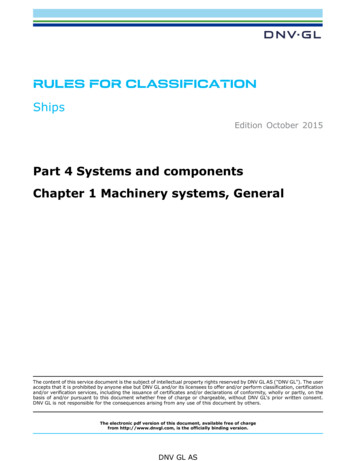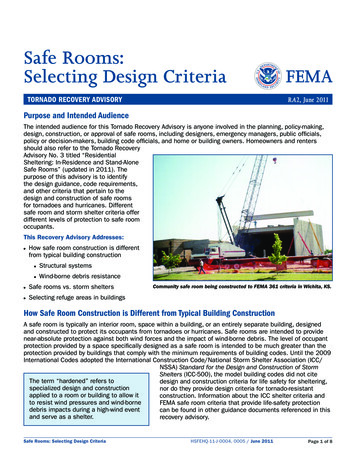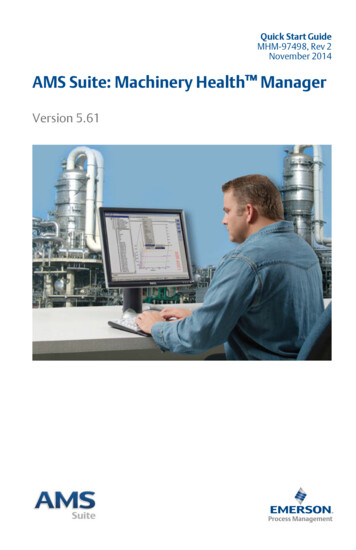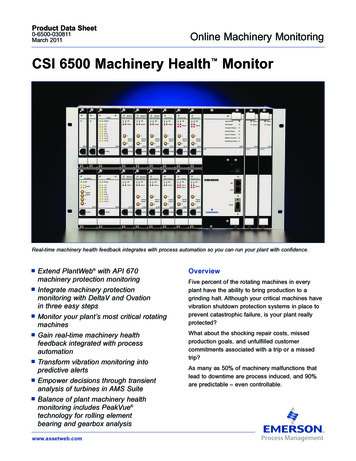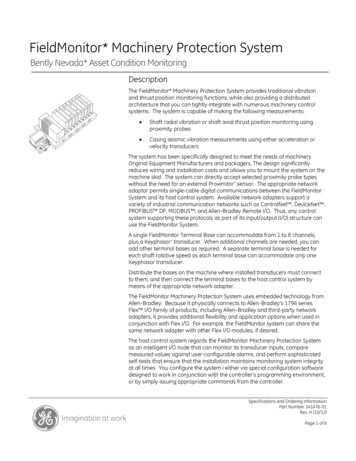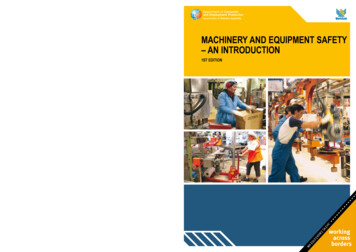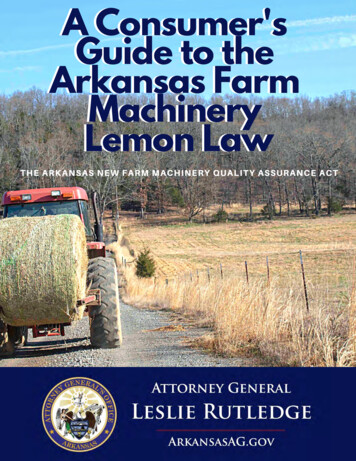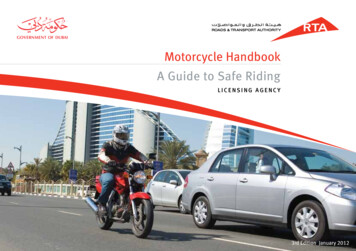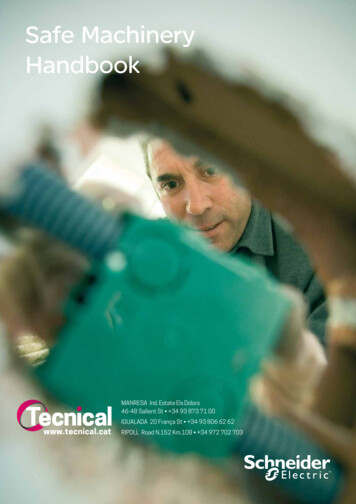
Transcription
Safe MachineryHandbookMANRESA Ind. Estate Els Dolors46-48 Sallent St 34 93 873 71 00IGUALADA 20 França St 34 93 806 62 62www.tecnical.catRIPOLL Road N.152 Km.108 34 972 702 703
MANRESA Ind. Estate Els Dolors46-48 Sallent St 34 93 873 71 00IGUALADA 20 França St 34 93 806 62 622www.tecnical.catRIPOLL Road N.152 Km.108 34 972 702 703
MANRESA Ind. Estate Els Dolors46-48 Sallent St 34 93 873 71 00IGUALADA 20 França St 34 93 806 62 62www.tecnical.catRIPOLL Road N.152 Km.108 34 972 702 703ContentsIntroduction.4Why safety?.6Legal framework.10Risk assessment.16Safe design and safeguarding.22Functional Safety.30Control system standardsincluding worked examples.38Sources of information.56Annexes - architectures.58For more information call us on 0870 608 8 608or visit www.schneider-electric.co.uk3
IntroductionMANRESA Ind. Estate Els Dolors46-48 Sallent St 34 93 873 71 00IGUALADA 20 França St 34 93 806 62 624www.tecnical.catRIPOLL Road N.152 Km.108 34 972 702 703
There are various guides to machinery safetylegislation which tend to present a distorted view of therequirements of that legislation.This handbook is an attempt to provide information that is up-to-date and unbiasedin order to help machine builders and users to provide workers with machines thatare safe, legal, and efficient. It is not intended as an exhaustive guide to compliancewith safety legislation, nor as a replacement for referring to the relevant standardsthemselves; it is to guide you through the logical steps and to point you to the relevantsources of information.MANRESA Ind. Estate Els Dolors46-48 Sallent St 34 93 873 71 00IGUALADA 20 França St 34 93 806 62 62www.tecnical.catRIPOLL Road N.152 Km.108 34 972 702 7035
Why safetyMANRESA Ind. Estate Els Dolors46-48 Sallent St 34 93 873 71 00IGUALADA 20 França St 34 93 806 62 626www.tecnical.catRIPOLL Road N.152 Km.108 34 972 702 703
As well as the moral obligation to avoid harming anyone,there are laws that require machines to be safe, and soundeconomic reasons for avoiding accidents.Safety must be taken into account right from the design stage and must be kept in mind atall stages in the life of a machine: design, manufacture, installation, adjustment, operation,maintenance and eventual /operationMaintenanceNew machines - the Machinery DirectiveIn the UK, at present the Machinery Directive 98/37/EC is implemented as the Supply ofMachinery (safety) regulations 1992 as amended.From 29 December 2009 the relevant UK regulations will be the Supply of Machinery (safety)regulations 2008, which implement the European Machinery Directive 2006/42/EC.Machines have to comply with the Essential Health and Safety Requirements (EHSRs) listed inAnnex I of the Directive, thus setting a common minimum level of protection across the EEA(European Economic Area).Machine manufacturers, or their authorised representatives within the EU, must ensure that themachine is compliant, the Technical File can be made available to the enforcing authorities onrequest, the CE marking is affixed, and a Declaration of Conformity has been signed, beforethe machine may be placed on the market within the EU.MANRESA Ind. Estate Els Dolors46-48 Sallent St 34 93 873 71 00IGUALADA 20 França St 34 93 806 62 62www.tecnical.catRIPOLL Road N.152 Km.108 34 972 702 7037
Existing machines – the Work Equipment DirectiveThis is implemented in UK law as the Provision and use of Work Equipment Regulations 1998(PUWER 1998).It applies to the provision of all work equipment, including mobile and lifting equipment, in allworkplaces and work situations where the Health and Safety at Work etc Act 1974 (HSW Act)applies, and extends outside Great Britain to some offshore activities.They require that all equipment is suitable for use, and is inspected and maintained asnecessary to ensure that it remains so.The cost of accidentsSome of the costs are obvious, such as sick pay for injuredemployees, whereas some costs are harder to identify. The Healthand Safety Executive (HSE) give an example of an accident at adrilling machine that resulted in costs to the business of 45 000(HSE INDG355). However this does not include some of the lessobvious costs, and some estimates amount to double that figure.An accident analysed by Schneider Electric Ltd, the outcome ofwhich was a reversible head injury, cost the employer some 90000, of which only 37 000 was insurable. The full financial impactcan include increase in insurance premiums, lost production, lostcustomers and even loss of reputation.Some risk reduction measures can actually increase productivity;for example the use of light curtains to protect access points ofmachines can allow easier access for loading and unloading; zoningMANRESAInd. EstateElsshutDolorsof isolation devices can allow partsof a machineto bedown for46-48 SallentSt 34 93 873 71 00maintenance while other parts remainproductive.8IGUALADA 20 França St 34 93 806 62 62www.tecnical.catRIPOLL Road N.152 Km.108 34 972 702 703The regulationsapply to allemployers, theself-employed,and others whohave control of theprovision of workequipment.
MANRESA Ind. Estate Els Dolors46-48 Sallent St 34 93 873 71 00IGUALADA 20 França St 34 93 806 62 62www.tecnical.catRIPOLL Road N.152 Km.108 34 972 702 70399
Legal frameworkMANRESA Ind. Estate Els Dolors46-48 Sallent St 34 93 873 71 00IGUALADA 20 França St 34 93 806 62 6210www.tecnical.catRIPOLL Road N.152 Km.108 34 972 702 703
EC Directive:Legal instrument to harmonise the legislation of the European member statesDefines the essential health and safety requirements (EHSRs)Transposed into national law (act, decree, order, regulations)Standard:A “standard” is a technical specification approved by a recognised standardisation body forrepeated or continuous application, with which compliance is not compulsoryHarmonised standard:A standard becomes harmonised when published throughout the member statesPresumption of conformity:When a product conforms to a harmonised European standard, the reference to which hasbeen published in the Official Journal of the European Union for a specific Directive, and whichcovers one or more of the essential safety requirements, the product is presumed to complywith those essential safety requirements of the Directive. A list of such standards can beaccessed at t.aspIt is of coursenecessary toensure compliancewith all the otherEHSRs as well asthose for whicha Presumption ofConformity is givenby the use of aspecific standard.MANRESA Ind. Estate Els Dolors46-48 Sallent St 34 93 873 71 00IGUALADA 20 França St 34 93 806 62 62www.tecnical.catRIPOLL Road N.152 Km.108 34 972 702 70311
A B & C standards:European standards for the Safety of machinery form the following structure:AB1B2CType A standards(Basic safety standards) giving basic concepts, principles for design, and general aspectsthat can be applied to all machinery;Type B standards(Generic safety standards) dealing with one safety aspect or one type of safeguard that canbe used across a wide range of machinery:- Type B1 standards on particular safety aspects (e.g. safety distances, surfacetemperature, noise);- Type B2 standards on safeguards (e.g. two-hand controls, interlocking devices, pressuresensitive devices, guards);Type C standards(Machine safety standards) dealing with detailed safety requirements for a particularmachine or group of machines.MANRESA Ind. Estate Els Dolors46-48 Sallent St 34 93 873 71 00IGUALADA 20 França St 34 93 806 62 6212www.tecnical.catRIPOLL Road N.152 Km.108 34 972 702 703
When a Type-C standard deviates from one or moreprovisions dealt with by a Type A standard or by aType B standard, the Type C standard takes precedence.BS EN ISO 12100 -1, 12100-2, and 14121-1 areType A standards.Some examples of these types of standards are:EN ISO 12100ASafety of machinery - General principles for design - Risk assessmentand risk reductionEN 574BSafety of machinery - Two-hand control devices - Functional aspects principles for designEN ISO 13850BSafety of machinery - Emergency stop - Principles for designEN 62061BSafety of machinery - Functional safety of safety-related electrical,electronic and programmable electronic control systemsEN ISO 13849-1BSafety of machinery - Safety-related parts of control systems - Part 1:general principles for designEN 349BSafety of machinery - Minimum gaps to avoid crushing of parts of thehuman bodyEN ISO 13857BSafety of machinery - Safety distances to prevent hazard zones beingreached by upper and lower limbsBEN 60204-1EN ISO 13855BSafety of machinery - Electrical equipment of machines - Part 1:general requirementsSafety of machinery - Positioning of safeguards in respect of approachspeeds of parts of the human bodyEN 1088BSafety of machinery - Interlocking devices associated with guards -Principles for design and selectionEN 61496-1BSafety of machinery - Electro-sensitive protective equipment. Part 1:General requirements and testsBEN 60947-5-5Low-voltage switchgear and control gear - Part 5-5: Control circuitdevices and switching elements - Electrical emergency stopdevice with mechanical latching functionEN 842BVisual danger signals - General requirements, design and testingEN 1037BPrevention of unexpected start-upBEN 953General requirements for the design and construction of fixed andmovable guardsCPlastics and rubber machines - Injection moulding machines - SafetyEN 201requirementsEN 692CMachine Tools - Mechanical presses - SafetyEN 693CMachine Tools - Safety - Hydraulic pressesEN 289CPlastics and rubber machines – Presses - Safety requirementsEN 422CPlastics and rubber machines - Blow moulding machines - SafetyrequirementsCEN ISO 10218-1EN 415-3CRobots and robotic devices - Safety requirements for industrial robots- Part 1: RobotsSafety of packaging machines - Part 3: Form, fill and seal machinesEN 619CContinuous handling equipment and systems - Safety and EMCrequirements for equipment for mechanical handling of unit loadsEN 620CContinuous handling equipment and systems - Safety and EMCrequirements for fixed belt conveyors for bulk materialsMANRESA Ind. Estate Els Dolors46-48 Sallent St 34 93 873 71 00IGUALADA 20 França St 34 93 806 62 62www.tecnical.catRIPOLL Road N.152 Km.108 34 972 702 70313
Acts of parliament (primary legislation)An Act of Parliament creates a new law or changes an existing law. An Act is a Billapproved by both the House of Commons and the House of Lords and formally agreed toby the reigning monarch (known as Royal Assent). Once implemented, an Act is law andapplies to the UK as a whole or to specific areas of the country.An Act may come into force immediately, on a specific starting date, or in stages.The practical implementation of an Act is the responsibility of the appropriate governmentdepartment, not Parliament. For example, laws relating to transport issues would comeunder the administration of the Department for Transport.Delegated or secondary legislationDelegated or secondary legislation allows the Government to make changes to a lawwithout needing to push through a completely new Act of Parliament. The original Act (alsoknown as primary legislation) would have made provisions for future delegated legislationthat could alter the law to differing degrees.Statutory Instruments (SIs), often called orders or regulations, are a type of delegatedlegislation requiring Parliament’s approval - through the affirmative or negative procedure- before the change to the law can be made.AcoPs (Approved Codes of Practice)AcoPs are approved by for example the Health and Safety Commission, with the consentof the Secretary of State. They give practical advice on how to comply with the law. Ifyou follow the advice you will be doing enough to comply with the law in respect of thosespecific matters on which the Code gives advice.CoPsCodes of practice other than AcoPs are considered to be good practice only, and shouldbe regarded as guidance.Other documentsNon-harmonised standards and other documents from standards bodies, such as,Technical Specifications, Publicly Available Specifications, Published Documents, Draftsfor Development, etc., can contain useful guidance but should not be relied on to ensurecompliance with the law.MANRESA Ind. Estate Els Dolors46-48 Sallent St 34 93 873 71 00IGUALADA 20 França St 34 93 806 62 6214www.tecnical.catRIPOLL Road N.152 Km.108 34 972 702 703
Manufacturers’ responsibilitiesManufacturers placing machines on the market within the European Economic Area mustcomply with the requirements of the Machinery Directive. Note that “placing on the market”includes an organisation supplying a machine to itself, i.e. building or modifying machinesfor its own use, or importing machines into the EEA.Users’ responsibilitiesUsers of machines need to ensure that newly-purchased machines are CE marked, andaccompanied by a Declaration of Conformity to the Machinery Directive. Machines must beused in accordance with the manufacturer’s instructions.Existing machines taken into service before the Machinery Directive came into force donot need to comply, although they need to comply with PUWER and be safe and fit forpurpose.Modification of machines can be considered as manufacture of a new machine, even if foruse in-house, and the company modifying a machine needs to be aware that it might needto issue a Declaration of Conformity and CE marking.MANRESA Ind. Estate Els Dolors46-48 Sallent St 34 93 873 71 00IGUALADA 20 França St 34 93 806 62 62www.tecnical.catRIPOLL Road N.152 Km.108 34 972 702 70315
Risk assesmentMANRESA Ind. Estate Els Dolors46-48 Sallent St 34 93 873 71 00IGUALADA 20 França St 34 93 806 62 6216www.tecnical.catRIPOLL Road N.152 Km.108 34 972 702 703
In order for a machine (or other equipment) to be madesafe, it is necessary to assess the risks that can resultfrom its use. Risk assessment for machines is describedin BS EN ISO 14121-1.There are various techniques for risk assessment, and none can besaid to be “the right way” to perform a risk assessment. The BritishStandard specifies some general principles but cannot specify exactlywhat has to be done in every case. It would seem to be nice if thestandard could give a value or ‘score’ for each risk, and then a targetvalue for the maximum value that must not be exceeded, but that isnot the case for several reasons. The score that would be allocated toeach risk, as well as on the level of risk that can be tolerated, dependon a series of judgements, and will vary with the person doing thejudging as well as on the environment. For example the risks thatmight be reasonable in a factory employing skilled workers mightbe unacceptable in an environment where members of the public,including children, might be present. Historical accident/incidentrates can be useful indicators, but cannot give a reliable indication ofaccident rates that can be expected.MANRESA Ind. Estate Els Dolors46-48 Sallent St 34 93 873 71 00IGUALADA 20 França St 34 93 806 62 62www.tecnical.catRIPOLL Road N.152 Km.108 34 972 702 70317
Identify the limits of the machineryThat is, just what is being assessed? What are the speeds/loads/substances etc thatmight be involved? For example how many bottles is the extruder blow moulding per hour,and how much material is being processed at what temperature? Remember to includeforeseeable misuse, such as the possible use of a machine outside its specification. Whatis the expected life of the machinery and its application? How is it likely to be disposed ofat the end of its life?Identify the hazardsWhat aspects of the machine might cause harm to a person? Consider the possibility ofentanglement, crushing, cutting from tools, sharp edges on the machine or on the materialbeing processed. Other factors such as the stability of the machine, noise, vibration, andemission of substances or radiation also need to be considered, as well as burns from hotsurfaces, chemicals, or friction due to high speeds. This stage should include all hazardsthat can be present during the lifecycle of the machinery, including the construction,installation, and disposal.Examples of typical hazards are illustrated below, though this is not an exhaustive list. Amore detailed list can be found in BS EN ISO 14121-1.Who might be harmed by the identified hazards, and when?Who interacts with the machine, when, and why? Again remember foreseeable misuseincluding the possibility of use of a machine by untrained persons, and persons who mightbe present in the workplace; not just machine operators, but cleaners, security staff,visitors, and members of the public.Puncturing, stabbing,shearing, severing, cuttingCatching, entanglement,drawing in, trappingImpactElectrocutionDischarge of dangeroussubstancesBurnsCrushingExamples oftypical hazards areillustrated here,though this is notan exhaustive list.A more detailed listcan be found inBS EN ISO 14121-1.MANRESA Ind. Estate Els Dolors46-48 Sallent St 34 93 873 71 00IGUALADA 20 França St 34 93 806 62 6218www.tecnical.catRIPOLL Road N.152 Km.108 34 972 702 703
Prioritise the risks according to their seriousnessBS EN ISO 14121-1 describes this stage as Risk Estimation. This can be done bymultiplying the potential harm that can come from the hazard by the exposure to thehazard, remembering that there can be more than one person exposed.It is difficult to estimate the potential harm, given the possibility that every accident can leadto a fatality. However usually when there is more than one possible consequence, one willbe more likely than the others. All plausible consequences should be considered, not justthe worst case.The result of the Risk Assessment process should be a table of the various risks that existat the machine, together with an indication of the seriousness of each. There is not a single“risk rating” or “risk category” for a machine – each risk must be considered separately.Note that the seriousness can only be estimated – Risk Assessment is not a precisescience. Neither is it an end in itself; the purpose of Risk Assessment is to guide RiskReduction.Riskrelatedto thepotentialhazard Severityof thepotentialharmxProbabilityofoccurenceFrequency andduration of exposurePossibility ofavoiding or limitingthe probability of theocurence of anevent that couldcause harmMANRESA Ind. Estate Els Dolors46-48 Sallent St 34 93 873 71 00IGUALADA 20 França St 34 93 806 62 62www.tecnical.catRIPOLL Road N.152 Km.108 34 972 702 70319
Risk ReductionRisk reduction is dealt with in BS EN ISO 12100-2.Risk reduction is defined in terms of eliminating risk: “the aim of measures taken must be toeliminate any risk throughout the foreseeable lifetime of the machinery including the phasesof transport, assembly, dismantling, disabling and scrapping.”In general, if a risk can be reduced then it should be reduced. This has to be temperedby commercial realities though, and the UK Regulations use words like “reasonable”to indicate that it might not be possible to eliminate some risks without a grosslydisproportionate cost.The process of risk assessment is iterative – risks need to be identified, prioritised,quantified, design steps taken to reduce them (first by safe design, then by safeguarding),and then this process is to be repeated to assess whether the individual risks have beenreduced to a tolerable level and that no additional risks have be introduced. In the nextchapter we examine safe design and safeguarding.MANRESA Ind. Estate Els Dolors46-48 Sallent St 34 93 873 71 00IGUALADA 20 França St 34 93 806 62 6220www.tecnical.catRIPOLL Road N.152 Km.108 34 972 702 703
StartRisk estimationRisk evaluationIs themachinesafe?NoRisk evaluationIdentification of thepotential hazardsRisk analysisDetermination ofmachine limitsEndYesRisk reductionMANRESA Ind. Estate Els Dolors46-48 Sallent St 34 93 873 71 00IGUALADA 20 França St 34 93 806 62 62www.tecnical.catRIPOLL Road N.152 Km.108 34 972 702 70321
Safe design &safeguardingMANRESA Ind. Estate Els Dolors46-48 Sallent St 34 93 873 71 00IGUALADA 20 França St 34 93 806 62 6222www.tecnical.catRIPOLL Road N.152 Km.108 34 972 702 703
Inherently safe design measures(as per BS EN 12100-2, clause 4)Some risks can be avoided by simple measures; can the task that results in the risk beeliminated? Elimination can sometimes be achieved by automation of some tasks such asmachine loading. Can the hazard be removed? For example, the use of a non-flammablesolvent for cleaning tasks can remove the fire hazard associated with flammable solvents.This stage is known as inherently safe design, and is the only way of reducing a risk tozero.Removing the drive from the end roller of a roller conveyor will reduce the possibility ofsomeone being caught up by the roller. Replacing spoked pulleys with smooth discs canreduce shearing hazards. Avoidance of sharp edges, corners and protusions can help toavoid cuts and bruises. Increasing minimum gaps can help to avoid body parts gettingcrushed, reducing maximum gaps can eliminate the possibility of body parts entering.Reduced forces, speeds and pressures can reduce the risk of injury.Removal of shear traps by inherently safe design measuresSource: BS PD 5304Take care to avoid substituting one hazard for another. For example air-powered toolsavoid the hazards associated with electricity, but can introduce other hazards from the useof compressed air, such as injection of air into the body and compressor noise.Standards andlegislation expressa distinct hierarchyfor controls.The eliminationof hazards orreduction of risksto a tolerable level,by inherently safedesign measures isthe first priority.MANRESA Ind. Estate Els Dolors46-48 Sallent St 34 93 873 71 00IGUALADA 20 França St 34 93 806 62 62www.tecnical.catRIPOLL Road N.152 Km.108 34 972 702 70323
Safeguarding & complementary protective measures(as per BS EN 12100-2, clause 5)Where inherently safe design is not practicable, the next step is safeguarding. This measure can include, forexample, fixed guarding, interlocked guarding, presence sensing to prevent unexpected start-up, etc.Safeguarding should prevent persons from coming into contact with hazards, or reduce hazards to a safe state,before a person can come into contact with them.Guards themselves can be fixed to enclose or distance a hazard, or movable such that they are either self-closing,power-operated or interlocked.Typical protective devices used as part ofsafeguarding systems include:Interlock switches to detect the position of movable guards for control interlocking, usuallyto permit tasks such as loading/unloading, cleaning, setting, adjustment etc.Protection of operators is provided by stopping the machine when the actuator iswithdrawn from the head of the switch, when the lever or plunger is actuated, when theguard is opened or the guard hinge rotates through 5 – generally on machines with lowinertia (i.e. quick stopping times)MANRESA Ind. Estate Els Dolors46-48 Sallent St 34 93 873 71 00IGUALADA 20 França St 34 93 806 62 6224www.tecnical.catRIPOLL Road N.152 Km.108 34 972 702 703
Light curtains to detect approach to dangerous areasBy finger, hand or body (upto 14mm, upto 30mm and above 30mm resolution)Light curtains are typically used in material handling, packaging, conveyor,warehousing and other applications. They are designed for the protection of personsoperating or working in the vicinity of machinery, by the stopping of dangerousmovement of parts as soon as one of the light beams is broken. They make itpossible to protect personnel whilst allowing free access to machines. The absenceof a door or guard reduces the time taken required for loading, inspection oradjustment operations as well as making access easier.Safety mats to detect personsApproaching, standing in or climbing into the danger areaSafety foot mats are typically used in front of or around potentiallydangerous machines or robots. They provide a protection zonebetween the machine operators and any dangerous movements.They are mainly designed to ensure the safety of personnel, andsupplement safety products such as light curtains to enable freeaccess for the loading or unloading of machines. They workby detecting persons stepping onto the mat and instigating astopping of the dangerous movement.MANRESA Ind. Estate Els Dolors46-48 Sallent St 34 93 873 71 00IGUALADA 20 França St 34 93 806 62 62www.tecnical.catRIPOLL Road N.152 Km.108 34 972 702 70325
Solenoid interlocks (powered guards)to prevent opening of guardsDuring dangerous phases of operation. Unlike non-solenoid interlocks, theyare used on loads with high inertia i.e. where the stopping time is long and it ispreferable to permit access only when the dangerous movement has stopped.These are often used with either a time delay circuit (where machine stoppingtime is defined and known) or actual detection of zero speed (where stoppingtimes can vary) to permit access only when safe conditions are met.Interlocking devices should be selected and installed with regard to minimisingthe possibility of defeat and failure, and the overall safeguard should notunnecessarily impede production tasks. Steps to achieve this include:- devices fastened securely in a (fixed) place and requiring a tool toremove or adjust;- coded devices or systems, e.g. mechanically, electrically,magnetically or optically;- physical obstruction or shielding to prevent access to the interlocking devicewhen the guard is open;- the support for devices shall be sufficiently rigid to maintain correct operationTwo hand control stations and footswitchesUsed to ensure the operator is standing away from the dangerarea when causing dangerous movements (e.g. down stroke inpress applications)They provide protection primarily to the machine operator.Supplementary protection to other personnel can be providedthrough other measures, such as the positioning of light curtains.Enabling switches to permit access underspecific conditions of reduced riskTo areas for fault-finding, commissioning etc (e.g. jogging andinching), with a central position and 2 “off” positions (fully releasedor clenched).MANRESA Ind. Estate Els Dolors46-48 Sallent St 34 93 873 71 00IGUALADA 20 França St 34 93 806 62 6226www.tecnical.catRIPOLL Road N.152 Km.108 34 972 702 703
Monitoring of safety signals – control systemsThe signals from safeguarding components are typically monitored using safety relays,safety controllers or safety PLCs (collectively referred to as “safety logic solvers”), which inturn are used to drive (and sometimes monitor) output devices such as contactors.The choice of logic solver will depend upon many factors including the number of safetyinputs to process, cost, complexity of the safety functions themselves, the need to reducecabling through decentralisation using a fieldbus such as AS-Interface Safety at Work orSafeEthernet, or even the need to send safety signals/data over long distances acrosslarge machines or between machines on large sites. The now common use of complexelectronics and software in safety controllers and safety PLCs has, in part, driven theevolution of the standards relating to safety related electrical control systems.Two such standardsavailable at time ofwriting includeBS EN ISO 13849-1(directly replacingBS EN 954-1 inNovember 2009)and BS EN 62061.Safety relaySafety controllerCompact safety PLCModular safety PLCSafeguarding will usually involve the use of some kind of control system, and the MachineryDirective gives various requirements for the performance of the control system. In particularit states “Control systems must be designed and constructed in such a way as to preventhazardous situations from arising”. The Machinery Directive does not specify the use of anyparticular standard, but the use of a control system meeting the requirements ofharmonised standard(s) is one means of demonstrating compliance with this requirementof the Machinery Directive. Two such standards available at the time of writing are BS ENISO 13849-1 (replacing EN 954-1 in November 2009) and BS EN 62061.MANRESA Ind. Estate Els Dolors46-48 Sallent St 34 93 873 71 00IGUALADA 20 França St 34 93 806 62 62www.tecnical.catRIPOLL Road N.152 Km.108 34 972 702 70327
Complementary protective measures - Emergency stopAlthough emergency stops are required for all machines (the Machinery Directive allowstwo very specific exemptions) they are not considered to be a primary means of riskreduction. Instead they are referred to as a “complementary protective measure”. Theyare provided as a backup for use in an emergency only. They need to be robust,dependable, and available at all positions where it might be necessary to operate them.BS EN 60204-1 defines the following three categories of stop functions as follows:– Stop category 0: stopping by immediate removal of power to the machine actuators(uncontrolled stop);– Stop category 1: a controlled stop with power available to the machine actuators toachieve the stop and then removal of power when the stop is achieved;– Stop category 2: a controlled stop with power left available to the machine actuators.However stop category 2 is not usually considered suitable for emergency stops.Emergency stops on machinery must be “trigger action”. This means that their des
New machines - the Machinery Directive In the UK, at present the Machinery Directive 98/37/EC is implemented as the Supply of Machinery (safety) regulations 1992 as amended. From 29 December 2009 the relevant UK regulations will be the Supply of Machinery (safety) regulations 2008, which implement the European Machinery Directive 2006/42/EC.
